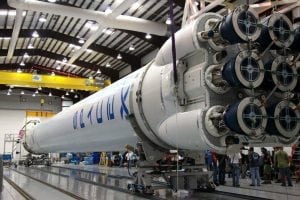Latest News

The Falcon 9 rocket in the hangar at SpaceX’s launch site at Cape Canaveral Air Force Station. Photo: SpaceX
[Via Satellite 04-28-2014] SpaceX is filing suit in the United States court of federal claims against the U.S. Air Force’s block buy of 36 cores from United Launch Alliance (ULA) for the Evolved Expendable Launch Vehicle Program (EELV). The decision to procure additional launches from ULA was made before SpaceX was able to complete the last leg of its certification to vie for national security launches. According to SpaceX CEO and Chief Designer Elon Musk, the company is only a few months away from being able to compete, and that it is merely paperwork that stands in the way.
“National security launches should be put up for competition, and they should not be awarded on a sole source uncompleted basis,” said Musk. “It just seems odd that if our vehicle is good enough for NASA and supporting a $100 billion space station — and it’s good enough for launching NASA science satellites, for launching complex commercial geostationary satellites, and really every satellite you can imagine — that there is no reasonable basis for it not being capable of launching something quite simple like a GPS satellite. This really doesn’t seem right to us.”
At a press conference in Washington D.C., Musk highlighted concerns about the Russian-built RD-180 engines ULA uses for its Atlas 5 rockets. NPO Energomash is the sole manufacturer of the RD-180, and is majority owned by Russia. This is a point of concern since Russia’s recent actions against Ukraine have sparked international backlash, including the White House’s March decision to sanction certain individuals such as Dmitry Rogozin, head of the Russian space sector.
“How is it that we’re sending hundreds of millions of U.S. tax payers’ money at a time when Russia is in the process of invading the Ukraine?” said Musk. “And it would be hard to imagine someway that Dmitry Rogozin is not benefiting personally from the dollars that are being sent there. On the surface of it, it appears there’s a good probability of some sanctions violation, as well.”
ULA and SpaceX both testified before congress on the competitiveness of the EELV program approximately a month ago. ULA, a joint venture between Boeing and Lockheed Martin, has already begun working on its block buy from the Air Force by ordering $178 million in hardware from ATK. SpaceX informed the Air Force of its intention to take legal action just before the press conference. Musk desires for the Air Force to cancel the block buy from ULA, and at minimum allow enough time for the full certification to be completed.
“This is not SpaceX protesting and [saying] that these launches should be awarded to us. We’re just protesting and [saying] that these launches should be competed,” said Musk. “If we compete and lose, that’s fine.”
Additionally, during the press conference, Musk provided an update on the status of the reusable Falcon 9 rocket, dubbed the Falcon 9R. SpaceX just tested the landing ability of the boost stage during the CRS-3 cargo resupply mission to the ISS.
“We were able to do a soft landing of the Falcon 9 boost stage in the Atlantic, and all the data that we received back shows that it did the soft landing and was in a healthy condition after that … we suspect that the stage was destroyed due to the stormy seas, but the data is very clear that it shows a soft landing. It shows deployment of all the legs, and that the stage was in a safe state in the water,” said Musk.
There is a video feed of the booster’s attempt a soft landing on the water, but the feed was reportedly very weak. SpaceX plans to release the video on its website to crowdsource help from video professionals. The company was unable to find boats in the greater Florida area that were capable of enduring heavy seas to retrieve the booster, which landed during a storm. Not even the U.S. Coast Guard was willing to look for the booster. SpaceX was only able to recover small bits and pieces from the test, but is confident that it went well.
“With this information that we’ve learned from this flight, we know we can soft-land the rocket, and we are taking some additional steps with the upcoming flight, which will be a commercial mission for Orbcomm, to have a much greater probability of getting to the stage in time and recovering it,” said Musk.
The boost stage makes up approximately 70 percent of the Falcon 9’s launch costs. According to Musk it would take a few months to refurbish the booster from the ocean but, if successfully landed back at a launch pad, it could be refueled and reused on the same day. The most recent test reached its return destination with an accuracy of a few miles, but on land the company expects “the accuracy of a helicopter.” None of SpaceX’s current pricing is based on reusability, but Musk said the cost savings stemming from salvaged boosters has the potential for a “hundred-fold improvement” in the cost of access to space.
“With each successive launch — we have several more launches this year — we expect to get more and more precise with the landing, and if all goes well, I am optimistic that we will be able to land the stage back at Cape Canaveral by the end of the year,” said Musk.
Get the latest Via Satellite news!
Subscribe Now